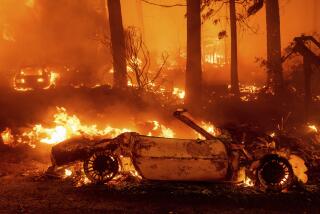Administration Held to Delay Wind Shear Radar
- Share via
WASHINGTON — The Reagan Administration came under sharp congressional criticism Wednesday for delaying development of sophisticated radar that would detect the sorts of sudden wind shifts associated with the crash of a Delta jetliner last month in Dallas.
“This Administration, with its get-the-government-out-of-everything philosophy, accepts little responsibility for ensuring and improving upon the public’s welfare and safety,” Rep. Norman Y. Mineta (D-San Jose), chairman of the House Public Works and Transportation subcommittee on aviation, charged.
Joint Hearings
Mineta appeared before a joint hearing of two House Science and Technology subcommittees that are examining the problem of wind shear--rapid changes in wind speed or direction--and federal development of new radar systems.
Wind shear has been linked to a 1975 crash of an Eastern Airlines plane at New York’s Kennedy Airport that killed 112 persons, the crash of a Pan American World Airways jet in New Orleans in 1982 in which 153 died and last month’s Dallas crash, which killed 136.
Rep. James H. Scheuer (D-N. Y.), co-chairman of the hearing, said that, if further tragedies are to be prevented, “we must install a reliable system for detecting severe wind shear and for communicating a timely warning to the pilot.”
The National Weather Service, the Federal Aviation Administration and the Defense Department have been developing a weather radar system called NEXRAD to detect tornadoes. Many experts believe that the NEXRAD system could be modified for use at airports to detect wind shear.
The FAA has estimated that the resulting system--called Doppler radar--could be installed at 110 airports at a cost of $500 million. Doppler radar already has been shown by tests to be capable of detecting wind shear.
Production Funds Delayed
But President Reagan’s Office of Management and Budget has delayed production funds for the NEXRAD radar system until fiscal 1987 and has requested that program officials review commercially available technology to see if it can perform the same job less expensively.
NEXRAD is scheduled to be available in late 1988. But NEXRAD program director Anthony F. Durham warned the House subcommittees that OMB’s requirement for a review of existing technology could delay delivery until 1990 or 1991.
And many experts insist that no systems are available to meet the government’s meteorological radar needs. “There is no evidence to suggest that this is currently possible,” Raymond G. Kammer of the Commerce Department, who is chairman of an advisory committee for the new weather radar system, told lawmakers.
Sen. Albert Gore Jr. (D-Tenn.), who worked on the wind shear problem as a House member until 1984, told the committee that OMB’s request for a review of existing technology is an excuse to delay the NEXRAD program. Gore has introduced legislation in the Senate calling for purchase of the new weather radar system “without any delay.”
$3 Billion Available
Mineta noted that there is a $3-billion federal aviation trust fund--fed by the 8% federal airline ticket tax--that could be used to install new Doppler radar systems at airports.
“The traveling public has paid a lot of money into the trust fund for safety . . . improvements such as . . . Doppler radar,” Mineta said. The public, he added, “has been stiff-armed by shortsighted Administration budget and regulatory policies.”
More to Read
Get the L.A. Times Politics newsletter
Deeply reported insights into legislation, politics and policy from Sacramento, Washington and beyond. In your inbox twice per week.
You may occasionally receive promotional content from the Los Angeles Times.









